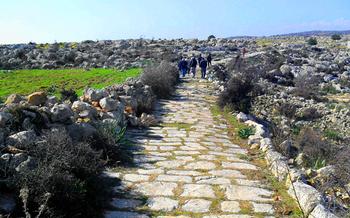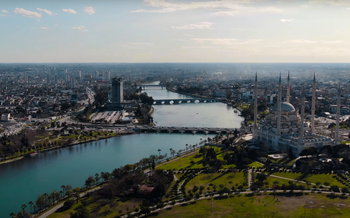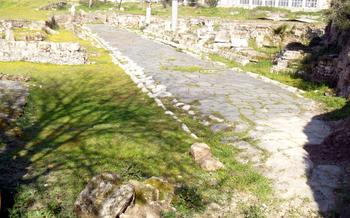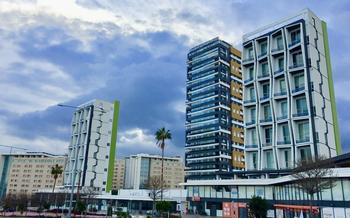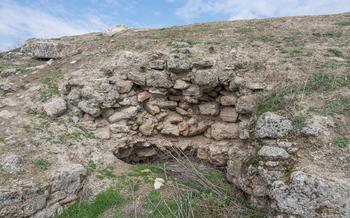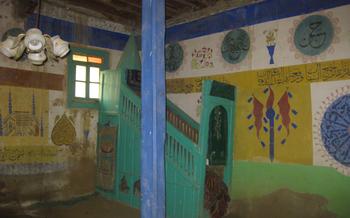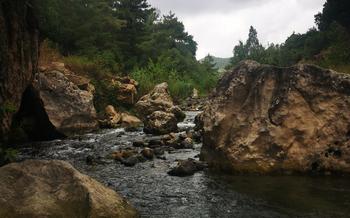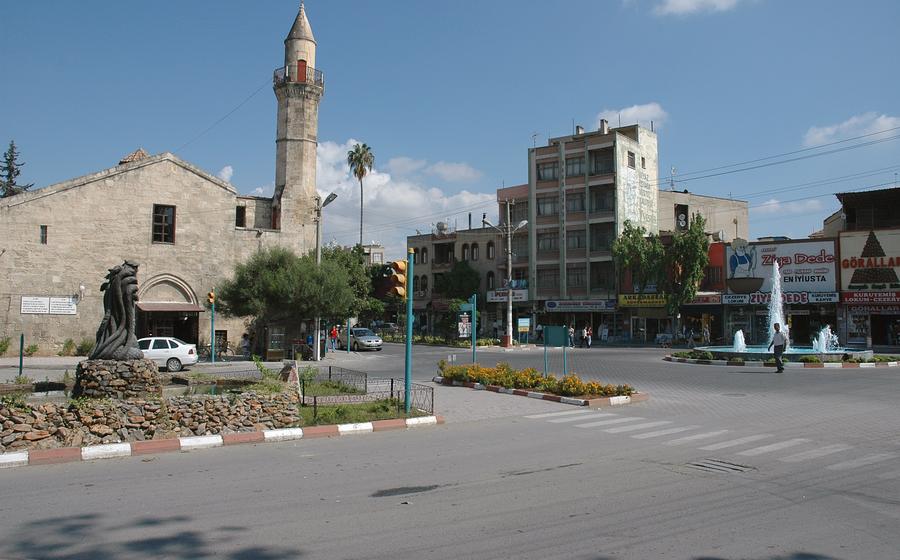
St. Paul's Church, Tarsus
- St. Paul's Church, Tarsus: A Historical and Religious Gem
- Tarsus: The Birthplace of St. Paul
- Exploring the Church's Interior
- St. Paul’s Well
- The Archaeological Museum of Tarsus
- St. Paul’s Grotto: A Sacred Retreat
- The Ancient City of Tarsus
- Local Cuisine
- Insider Tip
- Accommodation Options
- Transportation
- Shopping: A Treasure Trove of Local Handicrafts
- Local Festivals and Events
- Other Attractions in Mersin
- Safety and Cultural Tips
- Insider Tip: Unveiling the Hidden Gem of Tarsus
St. Paul's Church, Tarsus: A Historical and Religious Gem
St. Paul's Church, located in the heart of Tarsus, holds immense historical and religious significance for Christians worldwide. Built in the 12th century, the church is believed to stand on the site where St. Paul, one of the most influential figures in early Christianity, was born. Its impressive architecture, featuring a blend of Byzantine and Gothic styles, showcases intricate stonework, arched doorways, and a stunning bell tower that dominates the cityscape. As a pilgrimage site, the church attracts countless visitors who come to pay homage to St. Paul and seek spiritual enlightenment. The church's serene atmosphere, coupled with its rich history, makes it a must-visit destination for anyone interested in religious history and architecture.
During my visit to St. Paul's Church, I was captivated by its grandeur and the palpable sense of spirituality that filled the air. As I stepped inside, I couldn't help but feel a deep connection to the past, imagining St. Paul himself walking these very grounds. The intricate frescoes and mosaics that adorned the walls depicted biblical scenes, adding to the church's sacred ambiance. It was a truly awe-inspiring experience that left me with a profound sense of peace and tranquility.
Tarsus: The Birthplace of St. Paul
Tarsus, a city steeped in history and cultural heritage, holds a significant place in Christianity as the birthplace of the apostle Paul. Born in Tarsus around 5 CE, Paul, also known as Saul of Tarsus, was a Jewish man who became one of the most influential figures in the early Christian movement. His missionary journeys and letters played a crucial role in spreading Christianity throughout the Roman Empire and shaping the beliefs and practices of the early church.
Visiting Tarsus, you can't help but feel a sense of connection to this pivotal figure in Christian history. The city's rich heritage is evident in its ancient ruins, historical landmarks, and the vibrant local culture. As you explore the streets of Tarsus, you can imagine the young Paul walking these same paths, absorbing the sights, sounds, and influences that would later shape his teachings and ministry.
One of the highlights of a visit to Tarsus is undoubtedly the opportunity to delve into the city's Christian history. The city boasts several churches, monasteries, and historical sites associated with St. Paul, offering visitors a glimpse into the early days of Christianity. Whether you're a devout believer, a history buff, or simply curious about the origins of one of the world's most influential religions, Tarsus is a destination that will leave a lasting impression.
Exploring the Church's Interior
Stepping inside St. Paul's Church, you'll be struck by its serene and sacred atmosphere. The nave, with its rows of wooden pews, leads your gaze towards the altar, which is adorned with intricate carvings and a majestic cross. The walls are adorned with colorful frescoes depicting biblical scenes, adding to the church's spiritual ambiance.
Notable features of the church's interior include the baptismal font, believed to date back to the early days of Christianity in Tarsus. Its intricate carvings and symbolism offer a glimpse into the rich history of the church. Another highlight is the pulpit, crafted from finely polished wood and adorned with intricate carvings. From this pulpit, generations of priests have delivered their sermons, spreading the word of God to the faithful.
As you explore the church's interior, take a moment to reflect on its significance as a place of worship and pilgrimage. The church has stood as a testament to the enduring faith of the Christian community in Tarsus for centuries, and its atmosphere invites you to connect with the divine and seek spiritual renewal.
St. Paul’s Well
Just a short walk from St. Paul’s Church lies St. Paul’s Well, a revered site believed to have been used by the apostle himself. According to local tradition, St. Paul stopped at this well to quench his thirst during his travels. Over time, the well became a significant pilgrimage site for Christians, who believed its waters possessed healing properties.
The well is located in a small, serene courtyard surrounded by lush greenery. Its waters are crystal clear, and visitors can drink from it or collect some as a memento. The well holds deep religious significance for many Christians, who see it as a symbol of St. Paul’s presence in Tarsus and a reminder of his teachings.
During my visit, I couldn’t help but feel a sense of awe as I stood beside the well, imagining St. Paul using it centuries ago. I took a moment to drink from its cool, refreshing waters, feeling a connection to the past and the many pilgrims who had come before me. The well served as a reminder of the enduring legacy of St. Paul and the profound impact he had on the city of Tarsus.
The Archaeological Museum of Tarsus
The Archaeological Museum of Tarsus is a treasure trove of artifacts that provide a glimpse into the rich history and culture of the city. Located in the heart of Tarsus, the museum houses a vast collection of artifacts excavated from the ancient city and its surrounding regions.
Among the highlights of the museum is a collection of artifacts related to St. Paul, including a replica of the apostle's birthplace and a collection of coins depicting his likeness. These artifacts provide valuable insights into the life and times of St. Paul, and his connection to the city of Tarsus.
In addition to the St. Paul-related exhibits, the museum also features a diverse collection of artifacts from various periods of Tarsus's history. From prehistoric tools to Roman mosaics, the museum offers a comprehensive overview of the city's cultural heritage.
During my visit to the Archaeological Museum of Tarsus, I was particularly fascinated by a collection of ancient jewelry. The intricate designs and craftsmanship of these pieces were simply breathtaking, and they provided a glimpse into the artistry and skill of the ancient Tarsians.
Whether you are a history buff, a religious pilgrim, or simply someone interested in exploring different cultures, the Archaeological Museum of Tarsus is a must-visit destination. The museum's collection of artifacts, coupled with its informative displays, provides a unique and immersive experience that will leave you with a deeper understanding of Tarsus and its rich past.
St. Paul’s Grotto: A Sacred Retreat
Nestled amidst the rugged landscape of Tarsus, St. Paul’s Grotto stands as a testament to the apostle's profound connection to the city. This sacred site, believed to be the place where St. Paul sought refuge during his missionary journeys, exudes an aura of tranquility and spirituality.
According to local tradition, St. Paul found solace and inspiration within the grotto's secluded chambers. Believers from across the globe flock to this holy site to pay homage to the apostle and to experience the palpable sense of peace that permeates the air.
Venturing into the grotto, visitors are greeted by a simple yet evocative interior. The walls, adorned with intricate carvings and inscriptions, tell the story of St. Paul's life and teachings. A small altar, adorned with flickering candles, invites visitors to pause and reflect on the apostle's legacy.
Whether you're a devout Christian seeking spiritual connection or a history buff captivated by the life of St. Paul, a visit to the grotto is an unforgettable experience. As you stand within its hallowed walls, you can't help but feel a profound sense of awe and reverence for the man who left an indelible mark on the history of Christianity.
Personal Anecdote:
During my visit to St. Paul's Grotto, I was struck by a sense of serenity that washed over me as I stepped inside. The flickering candlelight cast an ethereal glow on the walls, illuminating the intricate carvings that depicted scenes from the apostle's life. As I sat in quiet contemplation, I couldn't help but feel a deep connection to this sacred space, where St. Paul had once sought refuge and guidance. It was a truly moving experience that left me with a lasting sense of peace and inspiration.
The Ancient City of Tarsus
The ancient city of Tarsus, where St. Paul was born, is a testament to the rich history and cultural heritage of the region. Founded by the Hittites in the 2nd millennium BC, Tarsus flourished as a major trade center during the Roman Empire. Its strategic location on the Cilician Plain made it a crossroads of civilizations, leaving behind a fascinating legacy of architectural wonders and historical landmarks.
During your visit to Tarsus, be sure to explore the ancient city's ruins, which offer a glimpse into its glorious past. The city walls, dating back to the Hellenistic period, still stand tall, providing a sense of the city's former grandeur. Within the walls, you'll find the remains of temples, theaters, baths, and other public buildings, each telling a story of the city's vibrant history.
One of the highlights of the ancient city is the Roman amphitheater, which could accommodate up to 20,000 spectators. Imagine the excitement and energy of the gladiatorial contests and other spectacles that once took place here. As you wander through the ancient ruins, you'll also come across remnants of the city's Byzantine and Islamic periods, showcasing the diverse cultural influences that have shaped Tarsus over the centuries.
Don't miss the opportunity to visit the ancient city of Tarsus and immerse yourself in the rich history and cultural heritage of this captivating destination. Whether you're a history buff, an architecture enthusiast, or simply someone curious about the past, you'll find plenty to explore and appreciate within the walls of this ancient city.
Local Cuisine
Mersin's culinary scene is a delightful tapestry of flavors and aromas, reflecting the region's rich cultural heritage. From traditional Turkish dishes to local specialties, there's something to tantalize every palate.
Strolling through the streets of Tarsus, you'll find an array of restaurants and eateries, each offering a taste of the city's culinary delights. For a truly authentic experience, venture into the local markets, where you can sample fresh produce, spices, and sweets.
One must-try dish is tantuni, a Mersin specialty consisting of thinly sliced beef or lamb grilled with tomatoes, onions, and parsley, wrapped in a crispy flatbread. The aroma of şalgam suyu, a fermented turnip juice, fills the air, a unique and refreshing beverage to accompany your meal.
For those with a sweet tooth, cezerye, a traditional Turkish delight made with carrots, sugar, and nuts, is a must-try. Its vibrant orange color and nutty flavor make it a popular treat among locals and visitors alike.
Insider Tip
For a truly unique dining experience, head to the Çukurova Mutfağı restaurant, located just a short walk from St. Paul's Church. This hidden gem serves up traditional Turkish cuisine with a modern twist, using locally sourced ingredients and innovative culinary techniques.
Their signature dish is the "St. Paul's Feast", a lavish spread of grilled meats, fresh vegetables, and homemade dips, all served on a bed of fragrant rice. It's a culinary journey that will transport you to the heart of Turkish hospitality.
Accommodation Options
Tarsus offers a range of accommodation options to suit different budgets and preferences. For those seeking a comfortable stay, the city boasts several hotels that provide modern amenities and convenient access to St. Paul's Church. Alternatively, budget-conscious travelers can opt for cozy guesthouses that offer a more local experience.
For those seeking a truly unforgettable experience, I highly recommend the St. Paul Hotel. This charming hotel is located just steps away from the church, offering guests a unique opportunity to immerse themselves in the history and spirituality of the area. The hotel's elegant rooms are decorated with traditional Turkish motifs and offer stunning views of the surrounding landscape.
During my stay at the St. Paul Hotel, I was particularly impressed by the warm hospitality of the staff. They went above and beyond to ensure that my stay was comfortable and memorable. From providing me with helpful travel tips to arranging for a guided tour of the church, they truly made me feel like a valued guest.
Transportation
Getting to Tarsus from major cities in Turkey is relatively easy, with several transportation options available. The city is well-connected by air, road, and rail. The nearest airport is Adana Şakirpaşa Airport (ADA), located approximately 50 kilometers from Tarsus. From the airport, you can take a taxi or bus to reach the city.
Once in Tarsus, getting around is straightforward. The city has a well-organized public transportation system, including buses and minibuses, that can take you to most parts of the city. Taxis are also readily available and provide a convenient way to travel shorter distances. If you prefer to explore at your own pace, car rental services are available in Tarsus, allowing you to explore the city and its surroundings independently.
Here's a personal anecdote related to transportation in Tarsus:
During my visit to Tarsus, I decided to rent a car to explore the city and its surrounding areas. The process was smooth, and the car rental agency provided me with a reliable vehicle. Having the freedom to drive around allowed me to visit St. Paul's Church, the Archaeological Museum, and several other attractions conveniently. The roads in Tarsus are well-maintained, and navigation was easy using a GPS device. I highly recommend renting a car if you want the flexibility to explore Tarsus and its surroundings at your own pace.
Shopping: A Treasure Trove of Local Handicrafts
Tarsus offers a vibrant shopping scene, where visitors can immerse themselves in the local culture and pick up unique souvenirs and handicrafts. The traditional bazaar, located in the heart of the city, is a must-visit for those seeking authentic Turkish experiences. Here, you can haggle with friendly vendors over colorful carpets, intricate silver jewelry, and handmade ceramics.
For those interested in modern shopping experiences, Tarsus also boasts several modern shopping malls and boutiques. The Tarsus Galleria is a popular destination for fashion-forward shoppers, offering a wide range of international and local brands.
If you're looking for unique souvenirs, consider purchasing a hand-painted ceramic plate depicting the iconic St. Paul's Church or a hand-woven rug featuring traditional Turkish patterns. These items make for beautiful keepsakes that will remind you of your time in Tarsus.
Insider Tip: For a truly unique shopping experience, visit the local artisans' workshops in the old city. Here, you can watch skilled craftsmen create their beautiful wares and purchase one-of-a-kind pieces directly from the source.
Local Festivals and Events
Tarsus, being a vibrant city with a rich cultural heritage, plays host to a variety of local festivals and events throughout the year. These celebrations offer a unique opportunity to immerse yourself in the local traditions and festivities.
One of the most prominent festivals in Tarsus is the St. Paul Festival, held annually in June to commemorate the life and teachings of St. Paul. The festival features religious processions, traditional music and dance performances, and various cultural events.
Another notable event is the Tarsus International Orange Blossom Festival, held in May to celebrate the region's famous orange groves. The festival showcases local agricultural products, traditional crafts, and culinary delights, along with live music and entertainment.
If you plan your visit during one of these festivals, you'll have the chance to witness the city come alive with colors, music, and joyous celebrations. Be sure to check the dates in advance and allow ample time to fully experience the festivities.
Other Attractions in Mersin
Beyond the historical and religious significance of St. Paul's Church and Tarsus, Mersin offers a wealth of other attractions for travelers to explore. The region boasts a rich cultural heritage, stunning natural landscapes, and a vibrant modern vibe.
For those seeking a deeper dive into history, the ancient city of Soli-Pompeiopolis, located just a short drive from Tarsus, is a must-visit. With its well-preserved ruins, including an impressive amphitheater, ancient city walls, and various temples, Soli-Pompeiopolis offers a glimpse into the region's rich past.
Nature enthusiasts will find solace in the scenic landscapes of Mersin. Take a boat trip to the picturesque Cennet and Cehennem (Heaven and Hell) Caves, where you can marvel at the stunning rock formations and crystal-clear waters. For a more active adventure, explore the Taurus Mountains, which offer challenging hiking trails and breathtaking views.
Mersin is also a culinary paradise, with a diverse range of local specialties to savor. Indulge in the flavors of traditional Turkish cuisine, including freshly caught seafood, succulent kebabs, and delectable desserts. The city's vibrant markets are a great place to sample local delicacies and pick up souvenirs.
Whether you're a history buff, nature lover, or foodie, Mersin offers something for everyone. Embrace the region's rich heritage, soak up the natural beauty, and savor the local flavors for a truly unforgettable travel experience.
Safety and Cultural Tips
Tarsus is generally a safe city for travelers, but basic safety precautions are always advisable. Be aware of your surroundings, avoid walking alone at night, and keep valuables secure. When interacting with locals, remember to be respectful and observe local customs. Dress modestly, greet people with a handshake or nod, and avoid discussing sensitive topics such as religion or politics. A little effort in understanding and respecting local culture will go a long way in ensuring a positive and enriching experience.
Personal Anecdote:
During my visit to Tarsus, I had the opportunity to interact with several locals, including shopkeepers, restaurant owners, and fellow travelers. I was struck by their warmth and hospitality. In one instance, a shopkeeper noticed that I was struggling with my Turkish pronunciation and patiently helped me practice until I got it right. Such small acts of kindness made my time in Tarsus all the more memorable.
Insider Tip: Unveiling the Hidden Gem of Tarsus
Beyond the well-known attractions, Tarsus holds a secret gem that will captivate the hearts of history and nature enthusiasts alike: the hidden waterfall. Nestled amidst lush greenery, this cascading waterfall offers a tranquil escape from the bustling city. To reach this hidden paradise, take a scenic walk along the outskirts of Tarsus, following the gentle murmur of the water. As you approach the waterfall, the sound of the cascading water grows louder, creating a symphony of nature. The mist from the waterfall creates a refreshing ambiance, and the surrounding greenery provides a picturesque backdrop for this hidden gem. Pack a picnic lunch and enjoy a relaxing afternoon by the waterfall, immersing yourself in the beauty of nature and creating memories that will last a lifetime.
